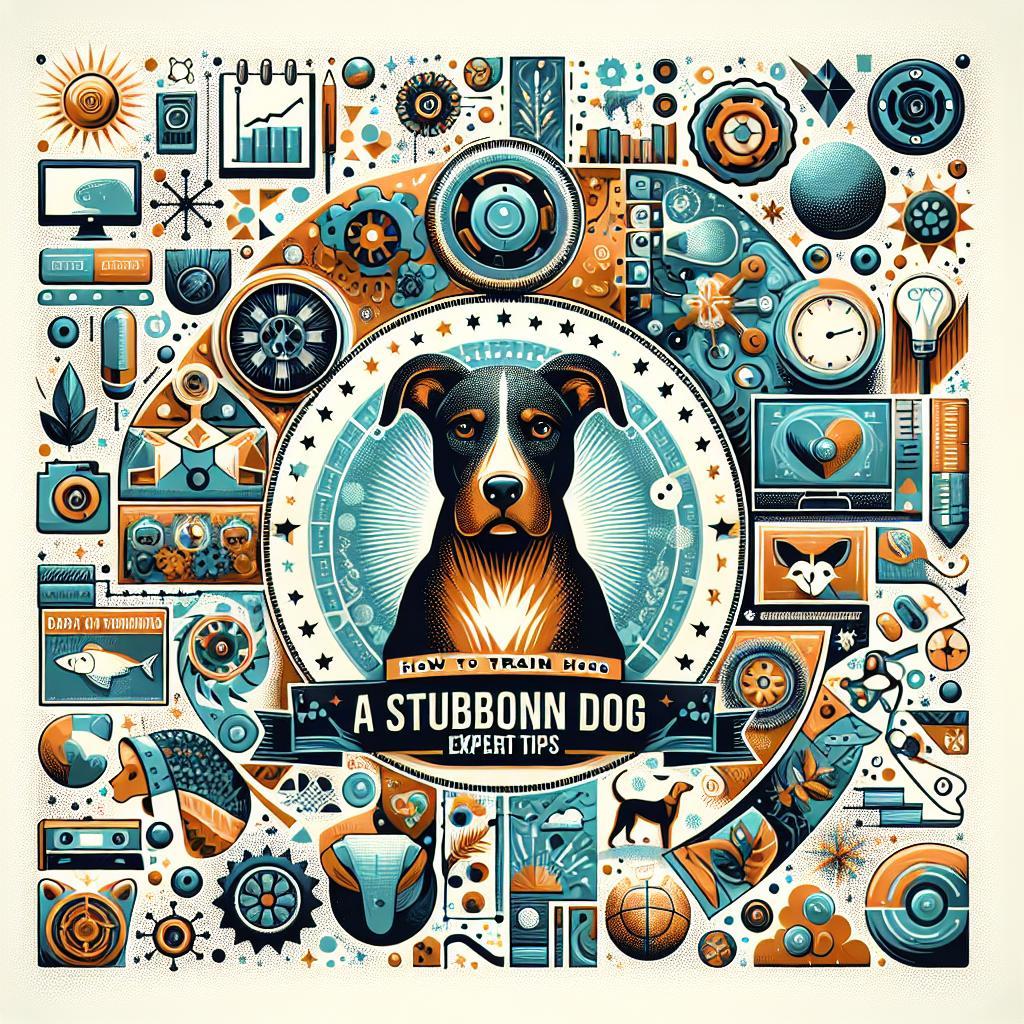How to Train a Stubborn Dog: Expert Tips
Training a dog can often feel like an adventure filled with joy and frustration in equal measure, especially when your furry companion seems to have a mind of their own. Stubbornness in dogs is not uncommon; many breeds are known for their independent spirits, making them both captivating companions and challenging students. Whether your canine companion is ignoring simple commands or stubbornly resisting your efforts to instill proper behavior, there’s hope. In this article, we’ll delve into expert tips and proven strategies that can help you navigate the complexities of training a stubborn dog. From understanding their unique perspectives to employing effective training techniques, we’ll equip you with the tools needed to forge a stronger bond and achieve your training goals. Join us as we explore the art of patience, consistency, and creativity in training your four-legged friend, transforming stubbornness into cooperation with love and persistence.
Understanding Your Stubborn Dogs Behavior
Understanding the behavior of a stubborn dog requires patience and a keen eye for the subtle cues they display. Often, what seems like disobedience is actually a form of communication. Dogs may act stubbornly when they are feeling anxious, bored, or misunderstood. To decipher these behaviors, observe the following aspects:
- Body Language: Pay attention to their posture, tail position, and ear movement. These physical signals can reveal their mood and intentions.
- Vocalizations: Barking, whining, or growling can indicate various emotions, from excitement to distress.
- Environment: Assess any changes in surroundings that might be contributing to their stubbornness, such as new people, pets, or noises.
Moreover, it’s essential to consider the dog’s breed characteristics. Some breeds are inherently more independent and strong-willed, which can contribute to stubborn behavior. When training, adopt an approach that aligns with their unique traits. Here are some strategies to effectively engage a reluctant learner:
| Strategy | Description |
|---|---|
| Positive Reinforcement | Reward desired behaviors with treats, praise, or playtime to encourage compliance. |
| Consistency | Use the same commands and cues consistently to avoid confusing your dog. |
| Short Sessions | Keep training sessions brief and engaging to maintain their interest and focus. |
Effective Communication Techniques for Training
Effective communication is paramount in training a stubborn dog, ensuring that both the trainer and the canine understand each other clearly. First and foremost, be consistent with commands and cues. Dogs thrive on routine and clarity, so using the same words and gestures for specific actions helps reinforce learning. Additionally, maintaining a calm and authoritative tone can have a significant impact on your dog’s receptiveness. Remember to use positive reinforcement consistently; rewarding good behavior not only motivates your dog but also strengthens the bond between you.
Body language plays a crucial role in how your dog interprets your messages. For instance, adopting an open stance, making eye contact, and offering gentle gestures can make your dog feel more secure and willing to engage. It’s also beneficial to keep training sessions short and engaging to avoid overwhelming your dog. Incorporate the following techniques to enhance communication during training:
- Visual Signals: Use hand signals alongside verbal commands.
- Patience is Key: Allow your dog time to respond and learn.
- Feedback Loop: Observe your dog’s reactions to adjust your methods accordingly.

Tailored Training Methods to Engage Your Dog
To successfully engage your stubborn dog during training, consider implementing tailored training methods that align with their unique personality and learning style. Each dog is different, so it’s essential to observe what motivates and resonates with your furry friend. Some effective strategies include:
- Positive Reinforcement: Use treats, praise, or toys to reward desired behaviors, creating a positive association with training.
- Interactive Play: Incorporate games such as fetch or tug-of-war into training to make sessions enjoyable and stimulating.
- Short Training Sessions: Keep sessions brief and focused to maintain your dog’s attention and prevent burnout.
Additionally, utilizing a consistent routine can greatly enhance your dog’s engagement level. Dogs thrive on predictability; thus, establishing a clear training schedule allows them to anticipate training times and prepare mentally. Consider the following tips for maintaining consistency:
- Set Regular Training Times: Establish specific times for training each day, adhering to this schedule as closely as possible.
- Use Consistent Cues: Use the same commands and signals for behaviors you wish to train, reinforcing understanding and compliance.
- Track Progress: Keep a simple log to note achievements and challenges, allowing you to adapt your methods as necessary.

Building Patience and Consistency for Lasting Results
Training a stubborn dog can often feel like an uphill battle, but cultivating patience is essential for progress. It’s important to remember that dogs, like people, learn at their own pace. If your furry friend struggles with new commands, take a step back and allow them the time they need. Here are some strategies to help foster patience in your training sessions:
- Set realistic goals: Focus on small, achievable milestones instead of overwhelming yourself or the dog with too many commands at once.
- Use positive reinforcement: Celebrate small victories with treats or praise to encourage your dog and build their confidence.
- Maintain a calm demeanor: Dogs can sense their owner’s frustration, so staying composed will help create a positive learning environment.
Consistency in training routines is equally crucial when dealing with a stubborn dog. Dogs thrive on predictability, so establishing a steady schedule can significantly enhance their learning experience. To ensure you’re on track with consistent approaches, consider the following tips:
- Establish a training schedule: Dedicate specific times each day for training to reinforce the habit.
- Be consistent with commands: Use the same word or phrase for commands every time to avoid confusing your dog.
- Involve the whole family: Ensure everyone in the household uses the same training techniques and language.
| Training Tips | Key Focus |
|---|---|
| Patience | Allow time for learning |
| Positive Reinforcement | Encourage with rewards |
| Consistency | Maintain regular training |
Q&A
Q&A: How to Train a Stubborn Dog: Expert Tips
Q: What are some characteristics that define a “stubborn” dog?
A: Stubborn dogs often display traits such as a lack of interest in commands, resistance to training sessions, selective hearing, and a tendency to do things their own way. Breeds like Bulldogs, Dachshunds, and some terriers are sometimes perceived as stubborn due to their independent nature, but it’s important to remember that each dog is an individual.
Q: How can I determine the best training method for my dog?
A: Understanding your dog’s personality is key. Observe how they respond to different types of reinforcement—some dogs may thrive on verbal praise, while others are more motivated by treats or playtime. Experiment with various training techniques, such as positive reinforcement, clicker training, or even agility exercises, and see which resonates most with your furry friend.
Q: Are there specific training techniques that work better for stubborn dogs?
A: Yes, employing techniques like consistency, patience, and gradual progression can be especially effective. Short training sessions with frequent breaks help keep your dog engaged. Techniques like the “Nothing in Life is Free” approach, where dogs must complete a command before receiving treats or play, can also encourage compliance.
Q: How can I build a stronger bond with my stubborn dog that aids in training?
A: Establishing trust is fundamental. Spend quality time engaging in activities your dog enjoys, whether it’s playing fetch, going for walks, or simply cuddling. Use these moments to create positive associations with training. The more your dog sees you as a reliable companion, the more likely they are to follow your lead.
Q: What should I do when my dog refuses to listen to commands?
A: When your dog seems unresponsive, take a step back. Assess the situation to eliminate distractions, and consider adjusting your training approach. Acknowledge their feelings; sometimes they may just need a break. Reinforcing commands in a more enticing manner—like using higher-value treats—can also reignite their interest.
Q: How important is consistency in training a stubborn dog?
A: Consistency is crucial! Dogs thrive on routine, so maintaining the same commands, signals, and rewards helps them understand your expectations better. Ensure everyone in the household uses the same commands and training practices to avoid confusion, which can further frustrate a stubborn pup.
Q: Are there any common mistakes to avoid when training a stubborn dog?
A: Absolutely! Avoid using negative reinforcement, as this can breed resistance and fear rather than compliance. Refrain from overwhelming your dog with too many commands or lengthy sessions. Lastly, remember to be patient—frustration can lead to setbacks, so maintain a calm demeanor throughout the training process.
Q: When should I seek professional help for stubbornness in my dog?
A: If you’ve made a concerted effort with training but continue to face challenges, consulting a professional dog trainer or behaviorist is wise. They can provide tailored strategies that fit your dog’s unique temperament and needs. Early intervention is best, especially if stubbornness leads to problematic behaviors.
By employing these expert tips and nurturing a positive environment, training a stubborn dog can become a rewarding journey rather than a frustrating struggle. Happy training!
In Retrospect
As we draw the curtain on our exploration of training stubborn dogs, it’s clear that patience is your most valuable ally. Each nudge toward understanding your furry friend is a step closer to a harmonious relationship filled with trust and love. Remember, every pup has its own unique quirks and challenges, but with the right tools and insights, you can transform those traits into strengths.
Training is not just about commands; it’s a journey of communication and connection. Celebrate the small victories along the way, and don’t be discouraged by setbacks—they’re all part of the process. With consistency, kindness, and a sprinkle of creativity, you’ll pave the path to a well-behaved companion who listens, learns, and loves unconditionally.
So buckle up, grab those treats, and embark on this adventure with your beloved canine. Here’s to forging an unbreakable bond built on trust, respect, and a little bit of stubbornness along the way!

